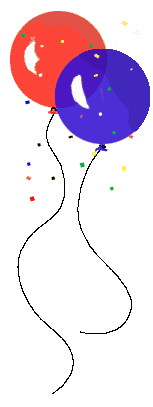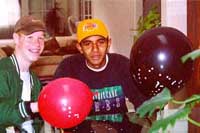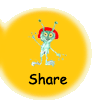
Ions in Action
Material: Instructions:
 Make
pieces of paper fly through the air and stick onto a
balloon.
Make
pieces of paper fly through the air and stick onto a
balloon.
Don't
forget to take off your hat before you rub the balloon on
your hair!

So,
Dr. Marc, why does the balloon pick up the confetti?
Atoms
are the teeny tiny particles that make up all matter. Atoms
have even teenier pieces, called electrons, that they
wear like coats. Sometimes the atom wears all its coats,
sometimes it takes off one or more. Atoms
that have either a negative or positive charge we call
ions. The Deep Space 1 spacecraft uses an ion
engine to propel itself through space! The
charged metal screen makes the xenon ions move very fast, so
they zoom right through the holes and out the other side of
the screen. As they shoot out (the action), they push
back against the spacecraft (the reaction). This
engine uses the same law of nature that makes a regular
fuel-burning rocket work. (See how to build
a pop-rocket.) The
forces of attraction are very strong in ion propulsion. The
ions actually move much faster than does the hot gas coming
out of a regular rocket engine. So the ion propulsion system
works even better!

 When
you rub the balloon on your hair, some of the electrons rub
off and stick to the balloon. The electrons have a negative
( - ) electric charge, so the balloon has a negative charge.
When atoms are missing electrons (they've taken off a coat
or two), we say they have a positive ( + ) charge. The
confetti you made has a few electrons missing, so has a
slight positive charge. Negative and positive charges
attract each other. So, the confetti sticks to the
balloon!
When
you rub the balloon on your hair, some of the electrons rub
off and stick to the balloon. The electrons have a negative
( - ) electric charge, so the balloon has a negative charge.
When atoms are missing electrons (they've taken off a coat
or two), we say they have a positive ( + ) charge. The
confetti you made has a few electrons missing, so has a
slight positive charge. Negative and positive charges
attract each other. So, the confetti sticks to the
balloon!
 The
ion engine contains a gas called xenon (pronounced
ZEE-non). The xenon is given a charge, just as the confetti
has a charge. Another part of the ion engine is a thin sheet
of metal with many little holes in it (sort of like a window
screen). This metal screen also has a charge, like the
balloon. So the metal screen attracts the xenon ions like
the balloon attracts the confetti.
The
ion engine contains a gas called xenon (pronounced
ZEE-non). The xenon is given a charge, just as the confetti
has a charge. Another part of the ion engine is a thin sheet
of metal with many little holes in it (sort of like a window
screen). This metal screen also has a charge, like the
balloon. So the metal screen attracts the xenon ions like
the balloon attracts the confetti.
|
|
|||||





